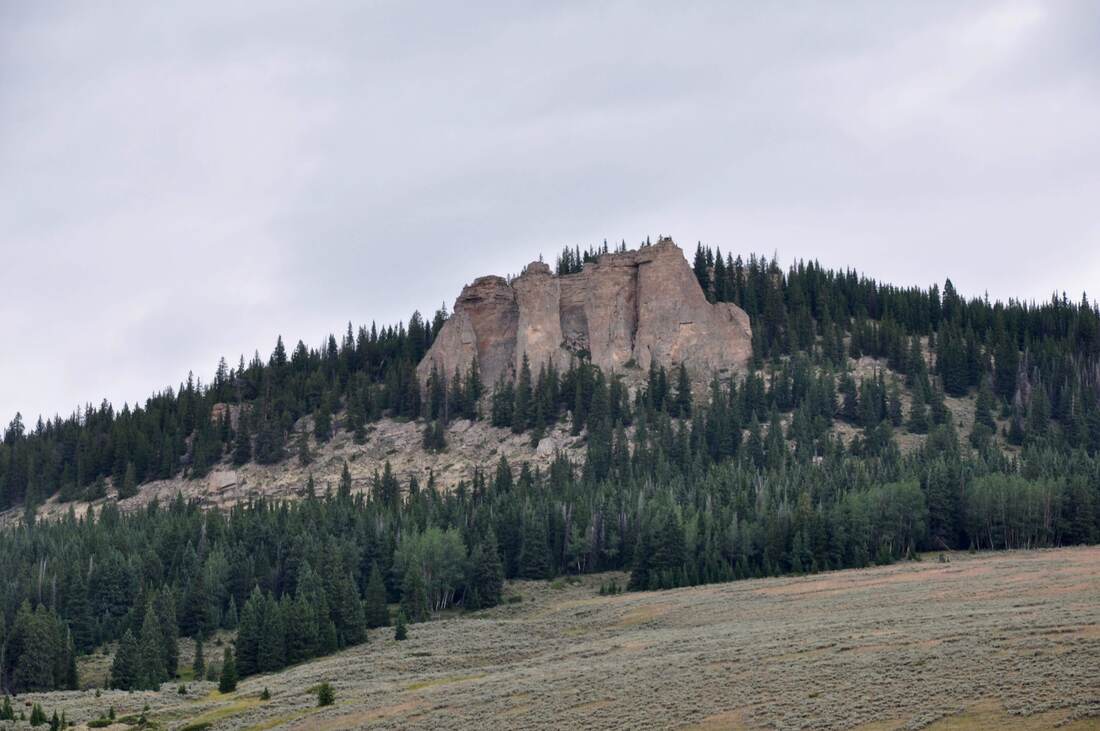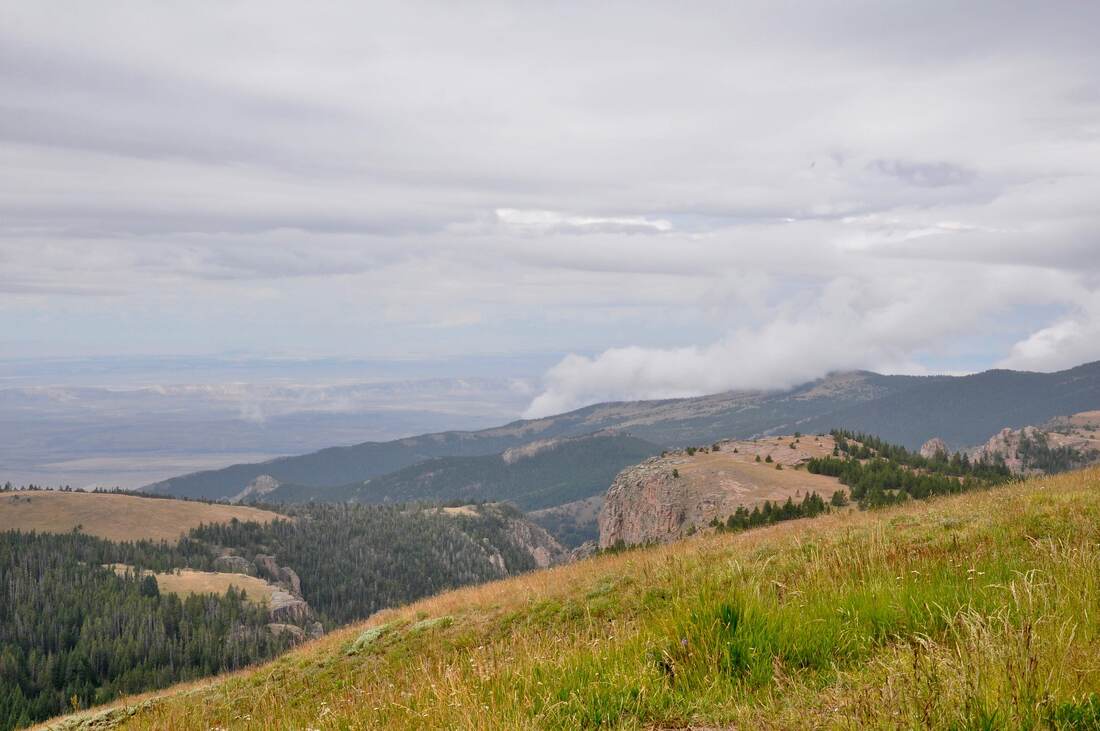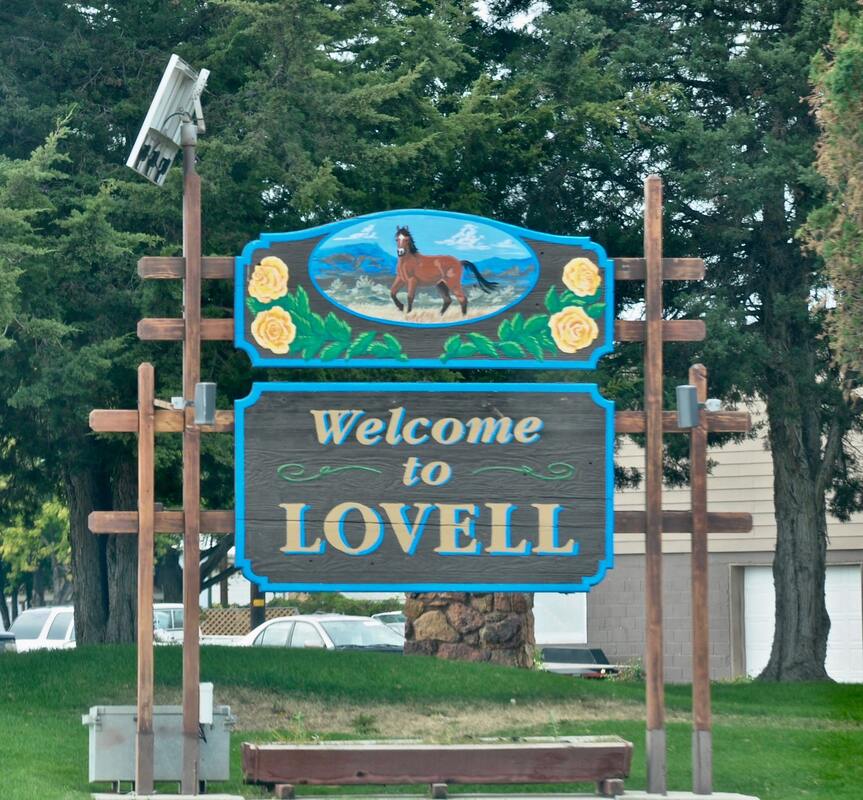|
The Bighorn National Forest covers a vast expanse of land in north central Wyoming. The geology of this protected area definitely is unique. When gazing at a map, the Bighorn National Forest actually is a tall mountain range that looks like a big island in the middle of the high plains. The Bighorn certainly is an entirely different world than the flat farm land down below. The base of the Bighorn is 5,000 feet above sea level and the mountain peaks are over 13,000 feet tall. Up high in the Bighorn the remaining thick forests are mixed in with cattle grazing meadows. The patches of towering rock outcrops are so inhospitable, that only one creature feels comfortable living in these conditions. This solitary animal species is the Bighorn Sheep, which happen to have the ability to climb up and down towering sheer cliffs with great ease. There are only two paved highways that go through the Bighorn and Highway 14 traverses the north end of this National Forest. Burgess Junction is where Highway 14 splits into three different directions in the north end of this wilderness area, which can lead to confusion. At Burgess Junction in the Bighorn, Highway 14 goes east to Dayton, Ranchester and Sheridan, which is where modern stores and accommodations can be found. Highway 14 also goes south to Greybull. The third travel route option at Burgess Junction is Highway 14A, which goes due west to the Bighorn National Recreation Area, the small town of Lovell and onward to Cody. The most popular scenic destinations and campgrounds in the Bighorn National Forest are located along Highway 14A going west and the scenic views are endless. All along this road are grassy mountain meadows, deep thick forests, towering majestic rock outcrops and plenty of good trout fishing streams. The ancient Medicine Wheel is also located on a hiking trail near 14A, so as can be imagined, an entire vacation can be planned around this section of road alone! All of the opportunities for outdoor adventures along Highway 14A do sound great, but a word of warning must be applied, especially for those who drive RV campers or haul trailers. Driving on top of the Bighorn is a piece of cake, because the roads go through rolling hills and mountain meadows. It is the western edge of the Bighorn where the fun begins. Highway 14A west has one of the steepest road grades in America. In fact, this type of ultra steep road grade was banned shortly after Highway 14A was completed. The uphill run on 14A will cause nearly any car to struggle to the point of overheating and the downhill run is guaranteed to absolutely scorch the brakes. For this reason, drivers of large RV campers and trailer haulers may want to select one of the other two Highway 14 options for the uphill and downhill rides. The U.S. National Forest Service describes the Bighorn as "a land of many uses" and this is clearly evident upon arrival in the high elevations. The Bighorn is a haven for wildlife, cattle ranching, horseback riding, sheep herding, outdoor sports, winter sports and off-road recreational vehicles of all kinds. This National Forest offers some of the best elk hunting and fly fishing in west, while the ATV and snowmobile trails conveniently run just about everywhere on the mountain. There are plenty of cross country ski trails and hiking trails too. To put it simply, the Bighorn certainly is an outdoorsman's dream come true! Wildlife viewing and nature photography is what many people like to do in the Bighorn Mountains and when the conditions are right, there is plenty of wildlife to see. Moose, elk, and mule deer are fairly easy to spot during the summer months. It does take a little more effort to spot some Bighorn Sheep on the high rocky outcrops, so be prepared to do some climbing to gain the opportunity. When hiking through the mountain top terrain, the friendly small animals like marmots, grouse and chipmunks all approach to say hello. There are also a few bears, coyotes, wolves and mountain lions on the mountain, so it does pay to be aware of the surroundings when exploring this wilderness area. Bears, wolves and mountain lions may sound dangerous, but anybody in Wyoming will readily inform a visitor as to what the most feared wild animal really is. By far, moose are the most dangerous animals in the Bighorn and a mama moose with a baby in tow is the most dangerous animal of them all. When a wild moose snaps, it will charge then rise up on its hind legs to pummel a victim to death, so it pays to adhere to the classic safe viewing distance rules. The new modern rule for safe wildlife viewing distances is easier to remember than the old 50 and 100 yard rules. When holding the thumb at arms length, the silhouette of a dangerous wild animal, like a moose, should be smaller than the view of the thumb. If the moose in the distance is bigger than the thumb, then it is time to carefully back away to a safe distance. The proverbial rule of thumb is easy to remember and it is now the safety standard at the Rocky Mountain National Park. The drive to the Bighorn National Forest is quite a distance from anywhere that a visitor may come from, so it is best to plan on spending at least a few days up on the mountain to make the long trip worthwhile. There are plenty of campsites in this National Forest and there are a few rustic lodges that may or may not suit one's own personal standards. For this reason, stocking up on plenty of food and camping gear before heading up the mountain is the best thing to do. Satellite communications are the only option in the Bighorn, so it is best to just plan on being completely cut off from the outside world while there. No matter whether the vacation plan calls for a week of rustic camping in the mountains or just taking a scenic drive, plenty of interesting things to do can be found along Highway 14A in the majestic Bighorn National Forest!
0 Comments
Your comment will be posted after it is approved.
Leave a Reply. |
Leave no trace!
New!
Destination West YouTube channel! https://www.youtube.com/@DestinationWestOrg *The Destination West website upgrading project is well underway. Unique YouTube slideshows are replacing the outdated Flickr photo galleries. The new videos feature modern graphics and alternative music instrumentals that enhance the viewing experience. Some articles are being condensed, while others are getting much needed edits. As everybody knows, the bulk of the original articles and photos were published on the fly during the Covid camping venture and there were limitations. Upgrading is the way to go and more articles will receive a makeover each week until this project is completed. After that, I will be able to gather new material. There is light at the end of the tunnel!
JD Lane Archives
July 2024
Donations help the Destinaton West project continue into the future!
Go Fund Me! This website uses marketing and tracking technologies. Opting out of this will opt you out of all cookies, except for those needed to run the website. Note that some products may not work as well without tracking cookies. Opt Out of Cookies |






























